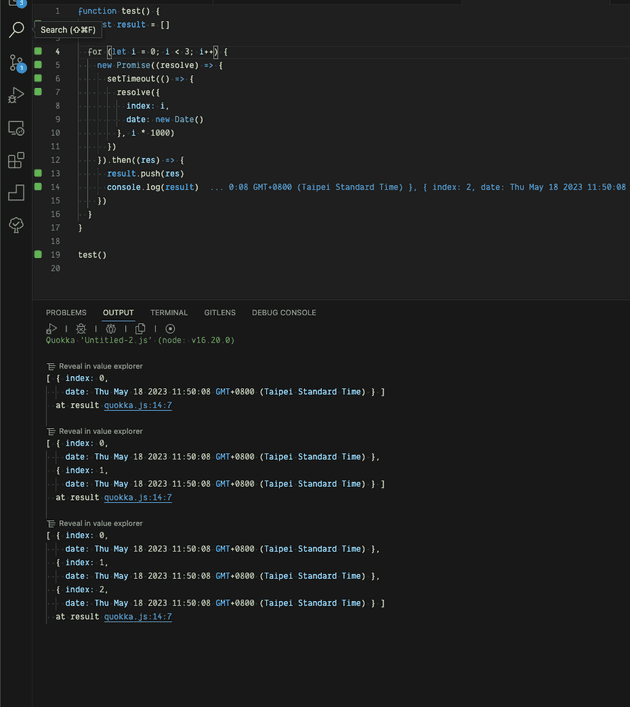Preface
要如何優雅的上傳大量的檔案呢?這是一個很常見的問題,但是大多數的人都會用一個一個的上傳,這樣的方式,所以當上傳的檔案數量很多的時候,就會變得很慢,而且也不太好管理,所以今天就來寫一下如何優雅的上傳大量的檔案。
Vue frontend code
下方是很簡單的上傳檔案的前端程式碼,這邊我有加上 webkitdirectory,讓使用者可以以選擇資料夾的方式進行上傳,這部分請依照自己的需求做修改。
後續我會將重點著重在 handleFileChange 這個 function 上面。
<script setup lang='ts'>
import { ref } from 'vue'
const inputRef = ref<HTMLInputElement>()
async function handleFileChange() {
// how to upload multiple files
}
</script>
<template>
<label for='file-input'>
<input
id='file-input'
ref='inputRef'
type="file"
webkitdirectory
multiple
@change="handleFileChange"
style='display: none'
/>
<button @click='inputRef?.click()'>Upload</button>
</label>
</template>
<style lang='scss' scoped></style>How to upload multiple files
其實上傳檔案的重點就是,你對 Promise 這個物件,是否有更深一層的了解。
async function handleFileChange() {
const files = (inputRef.value as HTMLInputElement).files
if (files) {
// 由於 files 是一個 FileList 物件,所以我們若想要使用 array 的方式操作他,需要將它轉成陣列
// 接著就可以用下方的方式做你需要的事情,當然你也可以單純的使用 for loop 來做
const fileList = Array.from(files)
.filter(file => {
if (file.name.startsWith('.')) return false // 濾掉 .DS_Store 這種檔案
if (file.type !== 'image/jpeg') return false // 濾掉非 jpeg 的檔案
return true
})
.map(...)
if (fileList.length !== 0) {
try {
// 解決方式一,也是大部分人都會使用的方式
// 很簡單的上傳檔案,但是這樣的方式,會讓上傳的檔案變得很慢
// 要等到前面結束,後面才會開始
for (let i = 0; i < fileList.length; i++) {
const file = fileList[i]
const formData = new FormData()
formData.append('file', file)
await uploadFile(formData)
}
// 解決方式二,使用 Promise.all 來加速上傳的速度
// 最大的原因是因為我們不需要等到上傳完一個檔案之後,才能上傳下一個檔案
// 且上一次的上傳,不會影響且這一次的上傳,也就是順序不重要
const BATCH = 20; // 我們每 20 個檔案一組,進行上傳
const promises = [] as Promise<void>[]
for (let i = 0; i < fileList.length; i++) {
const file = fileList[i]
const formData = new FormData()
formData.append('file', file)
// create promise then push into promises
const promise = async () => {
await uploadFile(formData)
}
promises.push(promise())
if (promises.length === BATCH || i === fileList.length - 1) {
await Promise.all(promises)
promises = []
}
}
// 解決方式三
// 但是使用 Promise.all 來加速上傳的速度,也有一個缺點,就是假設裡面有一個檔案上傳失敗,
// 整個流程就會變得很麻煩,而這時我們可以使用 Promise.allSettled 來解決這個問題,輸出時他會多一個 status 參數
const BATCH = 20 // 我們每 20 個檔案一組,進行上傳
const promises = [] as Promise<void>[]
for (let i = 0; i < fileList.length; i++) {
const file = fileList[i]
const formData = new FormData()
formData.append('file', file)
// create promise then push into promises
const promise = async () => {
await uploadFile(formData)
}
promises.push(promise())
if (promises.length === BATCH || i === fileList.length - 1) {
const res = await Promise.allSettled(promises)
// [{ status: 'fulfilled', value: undefined }, { status: 'rejected', reason: 'error' }]
// 接著你就可以做更多後續的處理
res.some(item => item.status === 'rejected') && throw new Error(`upload file error`)
promises = []
}
}
} catch (error) {
console.log(error)
} finally {
//
}
} else {
//
}
}
}Disadvantage by using Promise.all and Promise.allSettled
上述我們使用了 Promise.all 及 Promise.allSettled 來上傳多檔,也是作者我建議使用的方式,但是使用這兩個方式也是有缺點的,假使我們上傳檔案的大小是如下:
music1.mp4 (25MB)
music2.mp4 (25MB)
music3.mp4 (100GB) <-- upload slow
music4.mp4 (25MB) <-- 而這個檔案其實是有問題的,ex: error format music file
music5.mp4 (25MB)缺點就是必須要等到 batch 達到我們指定的數量,才會回傳結果,也就是說要等待 100GB 的檔案上傳完成,僅管 25MB 的檔案上傳有問題且已經報錯了,這情況其實是比較不樂觀的,而這時其實就可以回歸原點使用 uploadFile.then().catch() 的方式來進行處理,儘管使用此方法比較複雜,但好處是假使你在 batch 區間執行時已經發現錯誤,並想要 cancel 掉後續 API 的執行,甚至可以搭配 AbortController 來進行處理,因為比較複雜,下方僅是示意的程式碼及圖片,後續就交給讀者自己去實作了。
async function handleFileChange() {
let result = []
const batch = 3
for (let i = 0; i < 6; i++) {
new Promise((resolve) => {
setTimeout(() => {
resolve({
index: i,
date: new Date()
}, i * 1000)
})
}).then((res) => {
result.push(res)
if (result.length % batch === 0) {
result = []
}
}).catch((error) => {
//
})
}
}
Conclusion
在做公司內部的一些網站時,總會遇到這些奇奇怪怪的事情,像是有需求是要上傳超過 1000 個檔案之類的奇耙操作,總結一下,上傳檔案的重點其實就是,你對 Promise 這個物件,是否有更深一層的了解,希望對讀者能有所收穫。